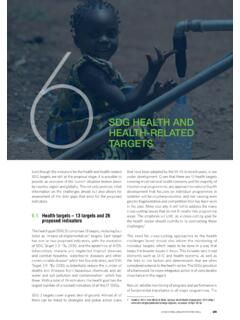Transcription of Mental health problems in children and young people - GOV.UK
1 Chapter 10. Mental health problems in children and young people Chapter authors Margaret Murphy1,2, Peter Fonagy3,4. 1 Consultant Child and Adolescent Psychiatrist, Cambridgeshire and Peterborough NHS Foundation Trust 2 Clinical Chair, Specialised Services Mental health Programme, NHS England 3 Head of Research Department of Clinical, Educational and health Psychology and Freud Memorial Professor of Psychoanalysis, University College London 4 Chief Executive, The Anna Freud Centre, London Annual Report of the Chief Medical Officer 2012, Our children Deserve Better: Prevention Pays Chapter 10 page 1. Mental health problems in children and young people Key statistics The British Child and Adolescent Mental health Surveys in 1999 and 2004 found that 1 in 10 children and young people under the age of 16 had a diagnosable Mental disorder.
2 Among the 5 to 10 year olds, 10% of boys and 5% of girls had a Mental health problem while among the 11 to 16 year olds the prevalence was 13% for boys and 10% for ,3. The most common problems are conduct disorders, attention deficit hyperactivity disorder (ADHD), emotional disorders (anxiety and depression) and autism spectrum ,3. Rates of Mental health problems in children and young people in the UK rose over the period from 1974 to 1999, particularly conduct and emotional In the absence of more recent data, it is unknown whether this trend has continued. Mental health problems in children and young people cause distress and can have wide-ranging effects, including impacts on educational attainment and social relationships, as well as affecting life chances and physical ,14.
3 Mental health problems in children and young people can be long-lasting. It is known that 50% of Mental illness in adult life (excluding dementia) starts before age 15 and 75% by age In addition, there are well-identified increased physical health problems associated with Mental 18. There are strong links between Mental health problems in children and young people and social disadvantage, with children and young people in the poorest households three times more likely to have a Mental health problem than those growing up in better-off Parental Mental illness is associated with increased rates of Mental health problems in children and young people , with an estimated one-third to two-thirds of children and young people whose parents have a Mental health problem experiencing difficulties ,25,57.
4 Mental health problems in children and young people are associated with excess costs estimated as being between 11,030. and 59,130 annually per These costs fall to a variety of agencies ( education, social services and youth justice). and also include the direct costs to the family of the child's illness. There are clinically proven and cost-effective interventions. Taking conduct disorder as an example, potential life-long savings from each case prevented through early intervention have been estimated at 150,000 for severe conduct problems and 75,000 for moderate conduct Annual Report of the Chief Medical Officer 2012, Our children Deserve Better: Prevention Pays Chapter 10 page 2. Mental health problems in children and young people overview or one of the less common disorders.
5 The prevalence increased dramatically in adolescence with rates of in those with no disorder, rising to in Mental health problems in children and young people those with an anxiety disorder and in those are common and account for a significant proportion with depression. In a 2007 survey of young adults,4 of the burden of ill health in this age range. The World of 16 24 year olds had attempted suicide and had health Organization (WHO) defines Mental health as not self-harmed in their lifetime. suicide is the leading cause of simply the absence of disorder but a state of wellbeing in death in young people . The suicide rate among 10 19 year which every individual realises his or her own potential, can olds is per 100,000; it is higher in males ( compared cope with the normal stresses of life, can work productively with for females) and in older adolescents ( among and fruitfully, and is able to make a contribution to her 15 19 year olds compared with among 10 14 year or his community'.)
6 1 This broader definition is particularly olds).5 Recent research has shown a significant fall in the rates appropriate in childhood and adolescence, as Mental health among young men in the period 2001 2010. is the foundation of healthy development and Mental health problems at this life stage can have adverse and Despite the increasing recognition of the importance of long-lasting effects. In this chapter we will focus mainly on the early years as a focus for early intervention, there has Mental disorders, the most severe end of the spectrum of been less research on the profile and rates of problems in problems . The use of the term Mental disorder' should not the under-5s and they were not included in the B-CAMHS. be taken as an indication that the problem is entirely within surveys.
7 One study showed that the prevalence of problems the child as Mental disorders can develop for a variety of for 3-year-old children was 10%, with 66% of parents reasons including a reaction to or interaction with external sampled having one or more concerns about their A. circumstances. further study showed that 7% of children aged 3 4 years exhibited serious behaviour Differentiating normal Rates and profile of Mental health problems from abnormal behaviour in younger children can be difficult and a substantial proportion of children will grow out of'. among children and young people early childhood problems , particularly among the under- The most recent British surveys carried out by the Office for 3s. However, longitudinal studies suggest that 50 60% of National statistics of children and young people aged 5 15 children showing high levels of disruptive behaviour at 3 4.
8 Years in 1999 and 20042,3 (referred to as the British Child years will continue to show these problems at school and Adolescent Mental health Surveys or B-CAMHS) found Moreover, neurodevelopmental problems including language that 10% had a clinically diagnosable Mental disorder delay, ADHD and autism spectrum disorders are first manifest ( a Mental health problem associated with significant in the pre-school years. impairment). Among the 5 to 10 year olds, 10% of boys and 5% of girls had a Mental disorder while among the 11 to 16 year olds the prevalence was 13% for boys and 10% for Are Mental health problems among children girls. In these two surveys the prevalence of anxiety disorders and young people becoming more common?
9 Was 2 3%, depression , conduct disorder 5%, There is a popular perception that children and young people hyperkinetic disorder (severe ADHD) and autism today are more troubled and badly behaved than previous spectrum disorders Rarer disorders including selective generations. Research looking over a 25-year period from mutism, eating disorders and tics disorders occurred in 1974 to 1999 found increases in conduct problems in young of children . Conduct disorders, hyperkinetic disorder and people , affecting males and females, all social classes and all autism spectrum disorders were more common in boys, and family There is also evidence for a rise in emotional emotional disorders were more common in girls. problems , but mixed evidence in relation to rates of hyperactivity.
10 There were no differences in rates between the young people aged 16 and over are included in the Office 1999 and 2004 B-CAMHS surveys. for National statistics surveys of adult psychiatric morbidity. As these surveys used different assessment methods and However, evidence for a recent rise in levels of psychological categories to the surveys of under-16s, direct comparison distress is provided by data from the West of Scotland is more difficult. In the 2007 survey of adults in England,4 Twenty-07 study10 in which marked increases in GHQ 12. in the 16 24-year-old age group experienced a caseness' (a scoring system for Mental health ) were found depressive episode, screened positive for post- in females between 1987 and 1999 and among both males traumatic stress disorder, experienced anxiety and females between 1999 and 2006.












